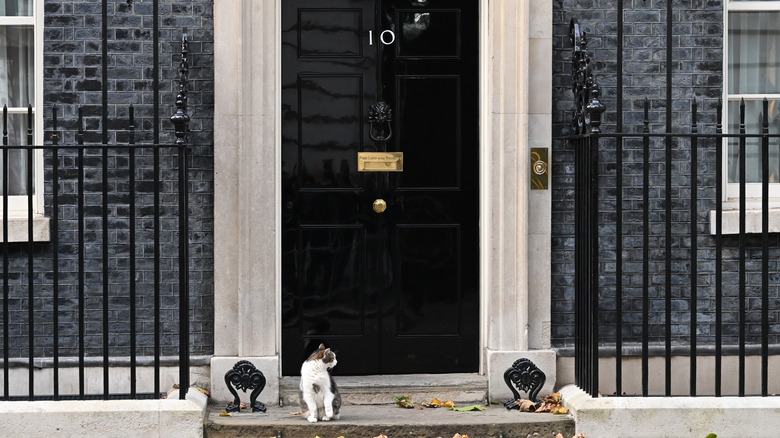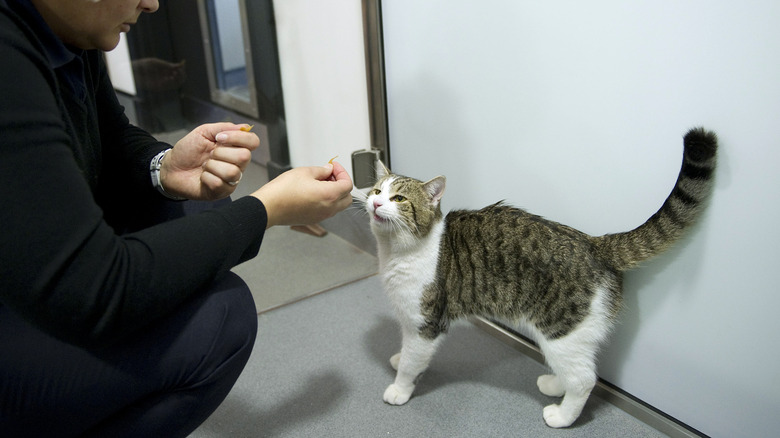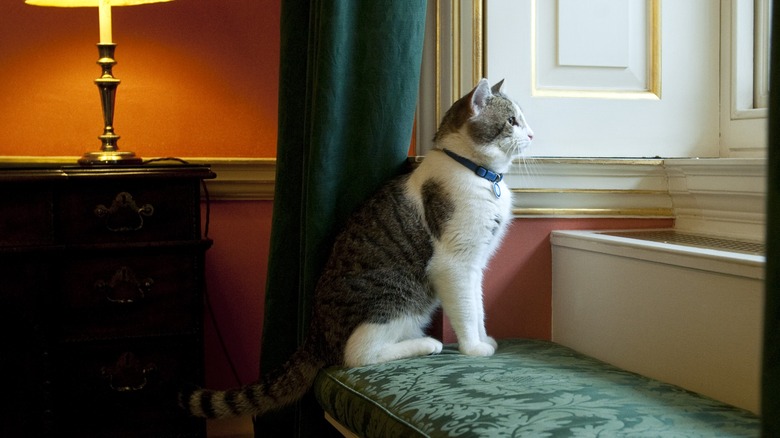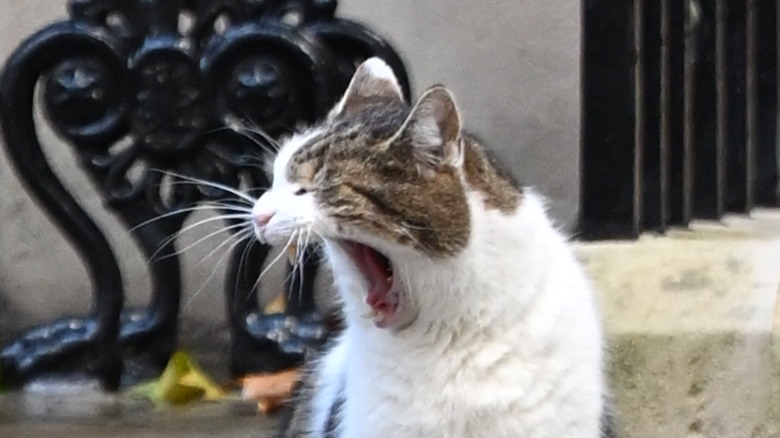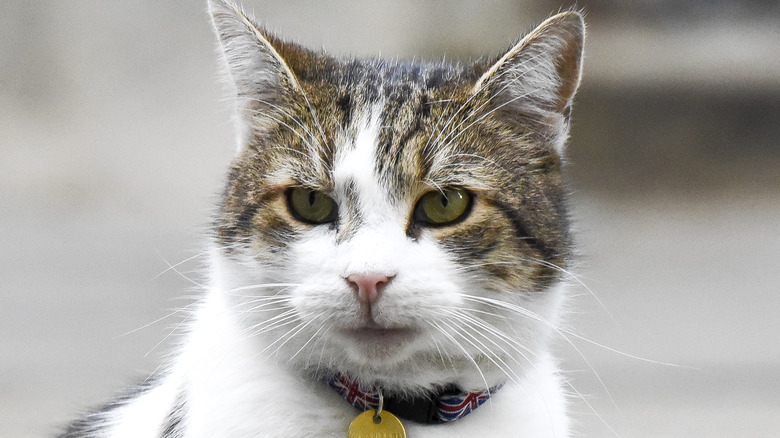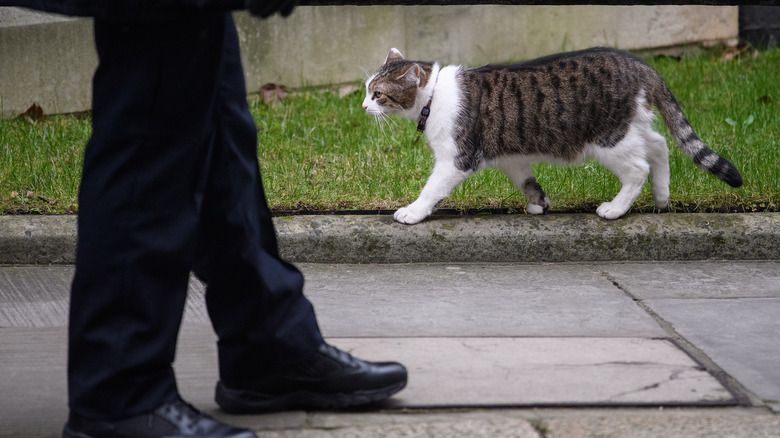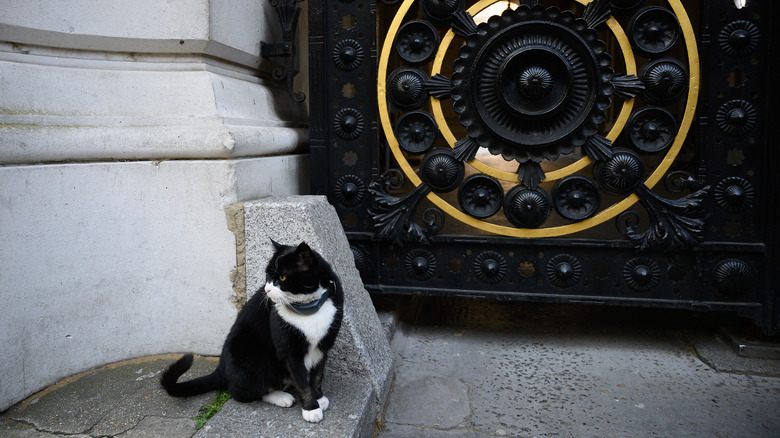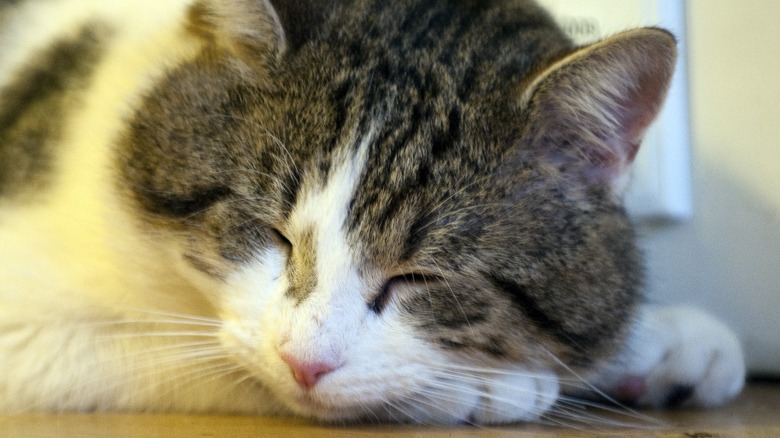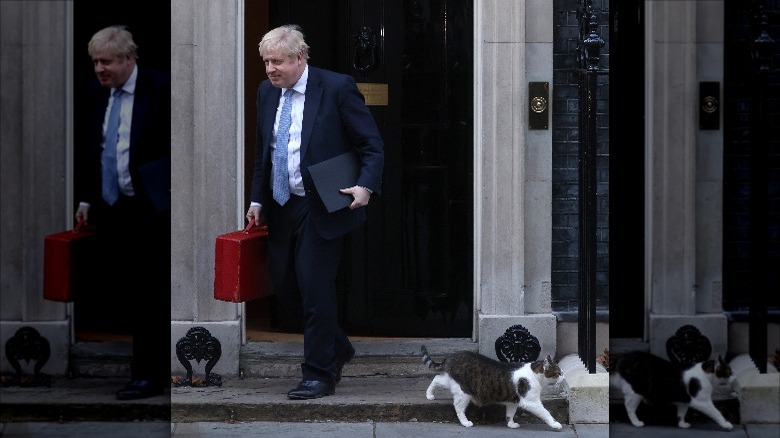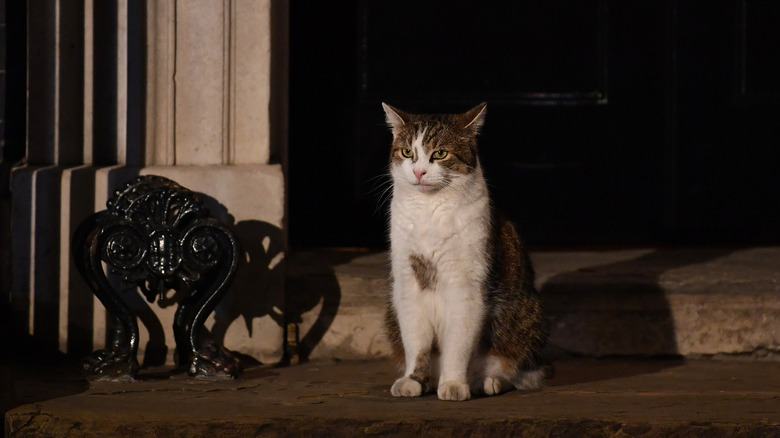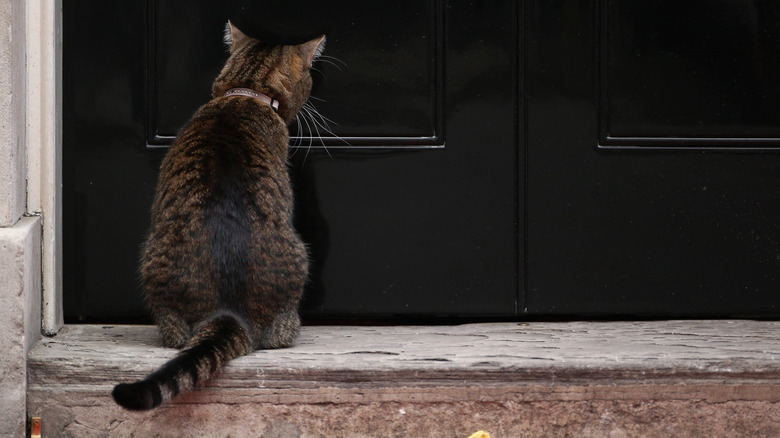The Life And Career Of Larry, The Downing Street Cat
It is no exaggeration to say that the second decade of the 21st century — plus a couple of years — was an especially tumultuous time in British politics. Hot on the heels of a contentious referendum for Scottish independence in 2014, as reported by the BBC, the country's Houses of Parliament were torn asunder — like much of the country as a whole — by the divisive Brexit campaigns of 2016 and the calamitous fallout that followed. Then, in unusually rapid succession, general elections took place in 2017 and 2019, and in the immediate years afterward, a huge churn of ministers resigned from government at an alarming rate, according to Statista.
With scandals such as Partygate and the Owen Paterson affair (via the Independent) taking a toll on the public perception of politicians, Britons' trust in the people that govern them seemingly fell to an all-time low, with a late-2022 survey of the public revealing that more than 70% of people were "embarrassed" by the latest developments in UK politics (via YouGov).
But while individual politicians come and go, and trust in the government as a whole may wane, there is one figure who has continued to command the respect and adoration of the British public: Larry, the brown-and-white tabby who lives at 10 Downing Street — the home of the British prime minister — and serves in an official capacity as chief mouser to the Cabinet Office, a job he has been in for more than a decade. Here is his story.
Larry the cat's early life
Unlike many other famous figures to have occupied 10 Downing Street, as described by the BBC, Larry the Cat didn't come from a wealthy background with a good network of connections. Instead, he started out on the streets of London as a stray kitten, who soon found himself having to take care of himself, exploiting whatever food and shelter he could find. According to Sky News, the stray was eventually found by operatives of Battersea Dogs & Cats Home — an animal shelter and rehabilitation center in the southwest of the capital — who took him in.
Larry — who was given his name by his carers at Battersea — adapted to his new surroundings well, gaining a reputation among staff as a feisty character who took great delight in practicing his predatory talents on toy mice.
So when in 2011, staff of 10 Downing Street — the home and executive offices of the British prime minister — approached Battersea on behalf of then-Prime Minister David Cameron, to identify a skilled mouser to help solve the growing rodent problem engulfing Downing Street, Larry was the first name that came to mind. Thus began Larry's first steps in a very public career, that would see him become one of the most beloved and steadfast figures in British politics over the next decade.
A proud mousing tradition
Though there hadn't been a live-in feline in 10 Downing Street for many years by the time Prime Minister David Cameron made the executive decision to install one, Larry's new job guarding the corridors of power against the disruptive presence of mice and rats was no innovation. Rather, it was the resurrection of a ceremonial duty with a long, proud tradition.
According to The Telegraph, Larry's predecessor in the role of chief mouser to the Cabinet Office was Humphrey, a stray like Larry who, in 1989, became a permanent fixture at Downing Street during the tenure of Prime Minister John Major — though he was later known to go AWOL from his duties. Indeed, he would indulge himself with extended stays at the homes of unsuspecting Londoners, who had no idea their new cat friend was a political celebrity with a vital role to play: making sure the levels of power remained unmolested by invasive rodents.
Humphrey was still in his role in 1997 when Tony Blair came to power, who bestowed him with the official title that Larry inherited. Another cat, Sybil, served for a period of two years beginning in 2007, under Prime Minister Gordon Brown, per the BBC. Prior to Humphrey was Wilberforce, and countless other Downing Street moggies down the centuries, with the BBC noting that it is believed that cats have been a similar mainstay in British politics all the way back to the reign of King Henry VIII.
Larry's performance
In 2011, with his purview — or perhaps "purrview" — of feline duties firmly set and with the mantle of chief mouser to the Cabinet Office in place (via Gov.uk), Larry had a lot to live up to, and for the first time in his life, Larry had to prove himself on the world stage.
However, Larry's results have not been encouraging. In fact, he seemed to be singularly failing in his core task — catching mice — so much so that he became notorious in the British press: He found himself on the receiving end of tabloid hit pieces, like any human politician who was proving to be under-qualified for a role at Downing Street. The Mirror newspaper, for example, reported as recently as 2018 that Larry was such a poor mouser that, on several occasions, external human exterminators had been called to deal with rodent infestations in the Cabinet Office.
Using a Freedom of Information Act request, the paper uncovered that experts had been called into Downing Street a total of 29 times in 2017 alone, leaving Larry's reputation in tatters. The same source branded the chief mouser "lazy," and suggested that he overlooked his duties in favor of finding warm sunny spots to sleep in.
Was Larry briefed against?
Questions over Larry the cat's abilities as a mouser have emerged ever since he first took up his role at the Cabinet Office way back in 2011, so much so that certain prominent political commentators suggested that — like many political figures arriving in Downing Street who have yet to prove themselves — Larry may have been intentionally undermined.
Larry was slow to offer a return on investment for Downing Street staff, who plied him daily with cat food, treats, and tickles. As reported by The Guardian, just two months into the job and after a regretful barren patch, Larry had finally rewarded his colleagues with his first kill — a mouse, which he displayed proudly from a Downing Street window, before presenting his work to a secretary. Nevertheless, rumors of Larry's poor mousing record continued to leak into the press, with ITV reporting a whole year later that Larry was still failing to make kills a year after being installed in Downing Street.
Such incongruities were noticed by The Independent's political columnist Andy McSmith, who in 2013 used his sources within Downing Street to get to the truth of the matter. It turned out that, according to some staff, Larry had long been a prodigious mouser, bagging several rodents a week on a good spell. McSmith, an acute observer of British politics, thus speculated a comparison between Larry's targetting by factions within Downing Street, and the more-real, fractured nature of the government at the time.
Does the British public pay for Larry the cat?
Whether or not Larry the cat is an adept mouse catcher, no mouser can live by kills alone. Any working cat with responsibilities such as Larry's is going to need compensation in the form of cat food, an ample supply of quality cat treats, and copious tickles from his human colleagues at 10 Downing Street.
But while the last of these requirements can be supplied at no cost, at the end of the day, someone has to pick up the bill for keeping the chief mouser of the Cabinet Office well-fed and watered as he goes about his duties. So how is Larry funded?
Seeing as he serves an official role, it might be natural to assume that Larry's supplies are paid for by the British taxpayer, just as the public purse funds the politicians and civil servants that Larry interacts with on a daily basis. However, according to The Guardian, Larry is a special case when it comes to funding, with his food and treats paid for through staff donations at special events, such as fundraising trivia nights hosted at Downing Street.
Larry's nemesis
While Larry the cat's position as chief mouser of the Cabinet Office has never been challenged, the respected brown-and-white tabby does have a professional rival he is often measured against: This rival's name is Palmerston, the chief mouser of the Foreign Office and a rescue cat who took up his role in 2016, according to the BBC.
That there was bad blood between Larry and Palmerston came to light just months after the latter's arrival: London newspapers such as The Evening Standard reported that the two famous felines had got into a very public spat in the street outside the Cabinet Office, which led to a physical confrontation between Larry and his nemesis. The scrap between Larry and Palmerston was so riotous that one of the cats — reports are sketchy — had their collar ripped off in the incident, according to photographic evidence supplied by the same source. The brawl had a negative effect on the public perception of Larry, contributing to his reputation for being difficult to work with.
Larry, however, had the last laugh, and Palmerston was retired in 2020, having served just four years at the Foreign Office, according to the BBC. Palmerston now lives a quiet life in the country, licking his wounds.
Did David Cameron steal Larry?
Larry the cat has had to deal with some difficult headlines during his time as chief mouser of the Cabinet Office. But in his first month on the job, a story was doing the rounds that claimed he shouldn't be in Downing Street at all. In fact, the story suggested that Larry was stolen property.
As reported by Digital Spy, Larry's first days in the corridors of power were marred by numerous reports that, rather than being a stray cat rescued by Battersea Dogs & Cats Home, he was actually a domestic cat who had been reported missing from a London home. Supposedly, Larry's real name was Jo, and his owners were starting an appeal on Facebook to ask Prime Minister David Cameron to return the cat to his rightful owners.
However, things weren't quite as they seemed. Per the same source, the story was, in fact, a hoax — concocted by media-savvy pranksters to highlight the lack of fact-checking in many stories reported by the mainstream British media. Per The Guardian, the story was shared on BBC radio, and in tabloids such as The Daily Mail and the Metro, the latter of which ran it under the headline: "Dear David Cameron: You've stolen my aunt's cat, please return him."
Larry's longevity
Though Larry the cat was installed by David Cameron as chief mouser of the Cabinet Office way back in 2011, he remained in his post immediately after his first boss' resignation in 2016. This came in the wake of his defeat during that year's Brexit referendum, during which Cameron campaigned for the UK to remain in the European Union — Larry's own preference in the divisive debate was not recorded.
In a profile of Larry published in 2021, celebrating the feline's first decade in the role, The Guardian noted that Cameron was regretful that he couldn't personally adopt Larry after he left office, telling his colleagues in the House of Commons: "Sadly, I cannot take Larry with me – he belongs to the house and the staff love him very much, as do I."
At the time of Larry's 10th anniversary at Downing Street, the same source noted that the chief mouser had outlasted two prime ministers in his time, with David Cameron being replaced by Teresa May, who then later resigned and was succeeded by Boris Johnson. However, the tumultuous nature of British politics in the early 2020s was illustrated by the fact that, less than two years later, the total number of prime ministers to have resigned under Larry's watch doubled, with Johnson's exit in disgrace in July 2022 shortly followed by that of Liz Truss in October, per NPR.
Larry's lost medal
As the years passed, Larry certainly became a respected figure around Westminster, and earned a cult following among the British public and political watchers overseas. David Cameron was effusive in his praise of his furry colleague, and received a warm reception when discussing their relationship in front of fellow conservatives and opposition Members of Parliament.
As reported by The Daily Telegraph, Cameron could be seen sharing a photograph of him sitting in an armchair in Downing Street, with Larry perching comfortably in the outgoing prime minister's lap. Such loyalty is rare in British politics — as is longevity — and as a result, many people therefore assumed that Larry would warrant a special mention in Cameron's resignation honors list: a special dossier assembled personally by the outgoing UK leader, identifying close aides and colleagues whom they believe are entitled to an award.
But as noted by The Daily Telegraph, Larry's name was conspicuous by its absence in the list, which contained many of Cameron's lifelong friends. Perhaps, it was suggested, Cameron wasn't quite as fond of the cat as he had suggested.
Beware of the cat
While David Cameron was happy to present to the world a cuddly image of his chief mouser, there have been several incidents — apart from his well-publicized brawl with Palmerston — that have revealed a darker side to Larry the cat than his press photos would have you believe.
Few politicians relish interviews, and it turns out that Larry is no exception. Back in 2011, Downing Street's newest fuzzy employee was caught on camera performing a surprise attack on a visiting journalist, Lucy Manning of ITV News, with stills of the premeditated clawing spilling out into the pages of The Daily Mail, along with graphic images of the scratch marks that Manning endured at the paws of the mouser.
It is unusual that women are the target of Larry's ire. As The Guardian notes, Larry is known to be suspicious of men in general, though he was reportedly friendly with Barack Obama when he visited Downing Street. Nor is Larry always violent: On the arrival of several visitors from Japan in 2018, Larry was spotted avoiding them when they attempted to interact with the chief mouser, according to The Shropshire Star.
Heroics caught on camera
Larry the cat's temperament may have meant that his fuzzy face wasn't the friendliest that a visitor could meet at the Cabinet Office, but his bravery in upholding the security of 10 Downing Street was never in question. Indeed, in October 2022, it was widely reported — both in Larry's native UK and abroad — that the chief mouser wasn't just capable of fending off rodents from the corridors of power, but larger prey as well.
Per The Washington Post, Larry fans were amazed when press footage emerged of the Cabinet Office cat facing off against an opponent even more formidable than Palmerston: A wild urban fox, which had entered Downing Street during a nighttime prowl around the streets of London.
No stranger to urban survival himself, having been born a stray in the British capital, Larry was seen stalking the much larger mammal, who attempted to avoid Larry's attention by loping into a nearby flower bed. Larry, however, still had his eye on the intruder, and darted in after him, after which the fox, at the mercy of Larry's swipes, fled the scene.
Britain's other famous felines
While Larry's job as chief mouser of the Cabinet Office is the most visible feline role in British public life, there have been several other cats — besides his troublesome neighbor Palmerston — that Larry has rubbed fuzzy shoulders with over the course of his long career.
One of these is Freya (pictured), a close colleague who worked with Larry during the early days of his tenure. Per The Independent, Freya was the cat of David Cameron's chancellor, George Osbourne, and shared mousing duties with Larry at both 10 and 11 Downing Street, the chancellor's official home. However, Freya was known to go absent without leave around London, and in 2014, when Osbourne brought his dog to Downing Street, Freya retired to the Kent countryside.
As of late 2022, the most recent feline to arrive in Westminster is Gladstone, who in 2016 took on the role of chief mouser at the Treasury at the prodigious age of just 18 months, according to the BBC. The source notes that, like Larry, Gladstone is a former stray who was adopted from Battersea Dogs & Cats Home, though a caption of a photo of the Treasury's new arrival suggested that the two former street cats had yet to meet one another.
